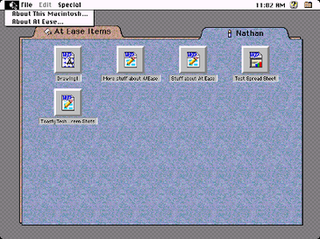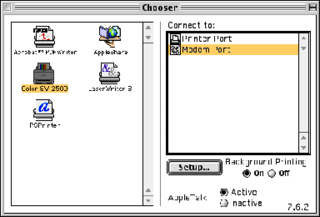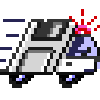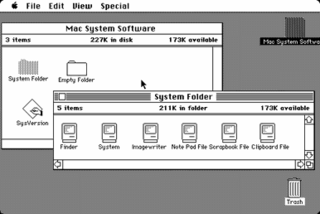 W
WThe classic Mac OS is the series of operating systems developed for the Macintosh family of personal computers by Apple Inc. from 1984 to 2001, starting with System 1 and ending with Mac OS 9. The Macintosh operating system is credited with having popularized the graphical user interface concept. It was included with every Macintosh that was sold during the era in which it was developed, and many updates to the system software were done in conjunction with the introduction of new Macintosh systems.
 W
WAt Ease was an alternative to the Macintosh desktop developed by Apple Computer in the early 1990s for the classic Mac OS. It provided a simple environment for new Macintosh users and young children to help them to work without supervision. At Ease replaces the Finder desktop, providing a simple tabbed panel-oriented graphical user interface in which applications and documents are represented by icons on large buttons. Aside from its security features, its interface and basic functionality is very similar to the Packard Bell Navigator.
 W
WThe Chooser is an application program for Macintosh systems using the classic Mac OS. The Chooser started out as a desk accessory and became a standalone application program as of System 7. The Chooser allowed users to connect to AppleShare file servers, enable or disable the network access, and select which printer to use.
 W
WHistorically, the classic Mac OS used a form of memory management that has fallen out of favor in modern systems. Criticism of this approach was one of the key areas addressed by the change to Mac OS X.
 W
WDisk First Aid is a free software utility made by Apple Inc. that was bundled with all computers running the classic Mac OS. This tool verifies and repairs a limited number of directory structure problems on any HFS or HFS Plus hard disk or volume.
 W
WThe dogcow, named Clarus, is a bitmapped image designed by Apple for the demonstration of page layout in Mac OS. The sound she makes is "Moof!". Clarus became the archetype of surrealistic humor in the corporate culture of the original Macintosh group, particularly as the mascot of Apple’s Developer Technical Support as officially documented in Technote #31.
 W
WExecutor is a software application that allows Motorola 68000-based classic Mac OS programs to be run on various x86-based operating systems. Executor was created by ARDI. As of 2005, Executor development has been indefinitely postponed; as of 2008, it was made available as open source software.
 W
WMac OS 8 is an operating system that was released by Apple Computer, Inc. on July 26, 1997. It includes the largest overhaul of the classic Mac OS experience since the release of System 7, approximately six years before. It emphasizes color more than prior versions. Released over a series of updates, Mac OS 8 represents an incremental integration of many of the technologies which had been developed from 1988 to 1996 for Apple's overly ambitious OS named Copland. Mac OS 8 helped modernize the Mac OS while Apple developed its next-generation operating system, Mac OS X.
 W
WMac OS 9 is the ninth and last major release of Apple's classic Mac OS operating system. Introduced on October 23, 1999, it was promoted by Apple as "The Best Internet Operating System Ever", highlighting Sherlock 2's Internet search capabilities, integration with Apple's free online services known as iTools and improved Open Transport networking. While Mac OS 9 lacks protected memory and full pre-emptive multitasking, lasting improvements include the introduction of an automated Software Update engine and support for multiple users.
 W
WMacintosh Guide, also referred to as Apple Guide, was Apple Computer's online help and documentation system, added to the classic Mac OS in System 7.5 and intended to work alongside Balloon Help. In addition to hypertext, indexing and searching of the text, Macintosh Guide also offered a system for teaching users how to accomplish tasks in an interactive manner. However, the process of creating guides was more complicated than non-interactive help and few developers took full advantage of its power. Apple enhanced the help system with HTML-based help in Mac OS 8.5 which worked in conjunction with Macintosh Guide providing links to Macintosh Guide sequences. Macintosh Guide was not carried over into Mac OS X, which uses an HTML-based help system.
 W
WSystem 6 is a graphical user interface-based operating system for Macintosh computers. It was released in 1988 by Apple Computer, Inc. and is part of the classic Mac OS series of operating systems. System 6 was included with all new Macintosh computers until it was succeeded by System 7 in 1991. The boxed version of System 6 cost $49 when introduced. System 6 is classed as a monolithic operating system. It features an improved MultiFinder, which allows for co-operative multitasking.
 W
WThe Macintosh "System 1" is the first version of Apple Macintosh operating system and the beginning of the classic Mac OS series. It was developed for the Motorola 68000 microprocessor. System 1 was released on January 24, 1984, along with the Macintosh 128K, the first in the Macintosh family of personal computers. It received one update, "System 1.1" on December 29, 1984, before being succeeded by System 2.
 W
WSystem 6 is a graphical user interface-based operating system for Macintosh computers. It was released in 1988 by Apple Computer, Inc. and is part of the classic Mac OS series of operating systems. System 6 was included with all new Macintosh computers until it was succeeded by System 7 in 1991. The boxed version of System 6 cost $49 when introduced. System 6 is classed as a monolithic operating system. It features an improved MultiFinder, which allows for co-operative multitasking.
 W
WSystem 7, codenamed "Big Bang", and also known as Mac OS 7, is a graphical user interface-based operating system for Macintosh computers and is part of the classic Mac OS series of operating systems. It was introduced on May 13, 1991, by Apple Computer, Inc. It succeeded System 6, and was the main Macintosh operating system until it was succeeded by Mac OS 8 in 1997. Features added with the System 7 release included virtual memory, personal file sharing, QuickTime, QuickDraw 3D, and an improved user interface.
 W
W W
W W
W W
W